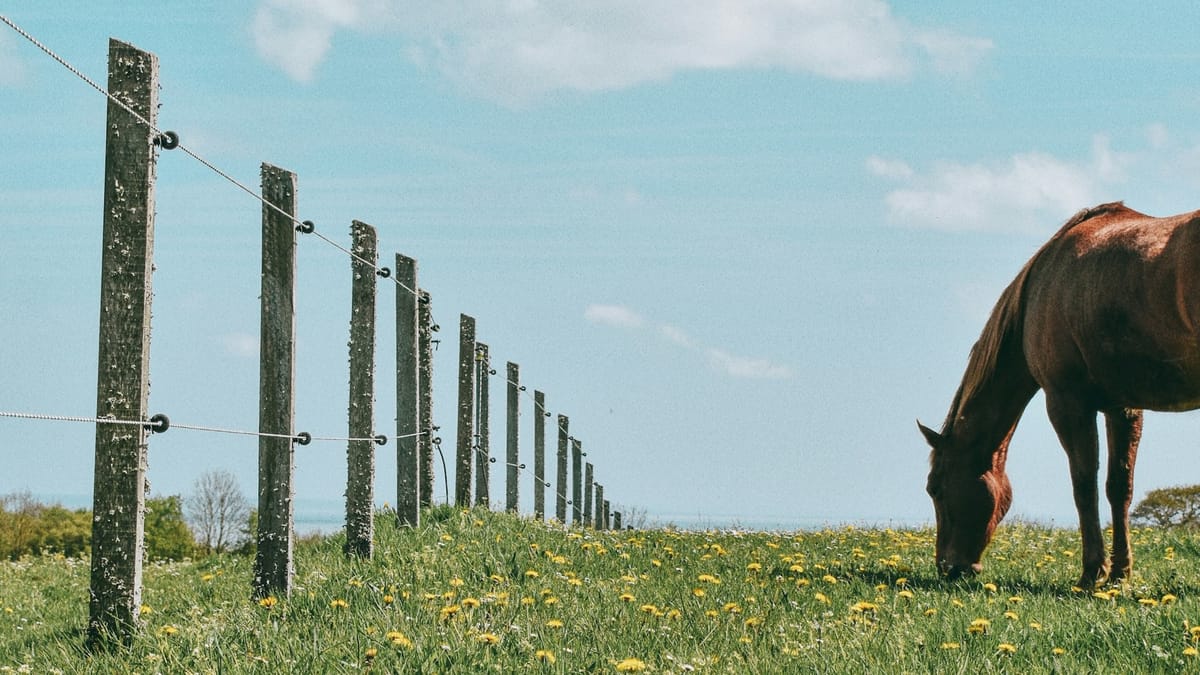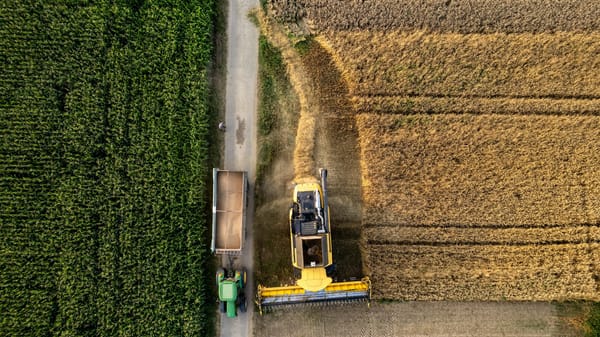The Prison of Fear and Comfort
Discover how fear and comfort intertwine to form the most insidious of prisons. This week’s issue is about wild horses, manipulation tactics, and the US Presidency.

I went for a walk and passed a paddock belonging to a riding school. Inside, some horses chased, bit, and kicked each other, stretched their necks to snatch a few blades of grass from the nearby meadow, or stood idly with dull eyes, waiting for time to pass. The paddock was enclosed by a loose electric wire, held up by small black plastic knobs on wooden posts.
What keeps these powerful creatures, descendants of some of the most majestic land mammals, from breaking free—racing across the open fields, feasting on lush green grass, or bonding, mating, and defending their territory with purpose?
These horses no longer control their own destiny. They are domesticated.
Domestication and Slavery
Domestication is not the same as slavery. A slave is someone who is either not capable or not willing to repay some form of debt. In this context, debt can refer to any form of self-incurred or forcibly imposed financial, labor, war, or inherited debt.
Slavery is an umbrella term for a diverse array of practices, such as
- Chattel Slavery: People are treated as property to be bought, sold, and inherited (e.g., Atlantic slave trade, pre-Civil War U.S. South, ancient Greece and Rome),
- Debt Bondage: Individuals working to repay debts, often under conditions that perpetuate their servitude (e.g., ancient Mesopotamia, indentured servitude in colonial America, Brick Kiln workers in India),
- Prisoner of War Slavery: Captives exploited as part of conquest and war spoils (e.g., Roman Empire, Islamic Caliphates, African intertribal wars),
- Forced Labor: Coercive conscription of workers (e.g., Soviet gulags, Nazi labor camps, China’s Uyghur labor camps, ancient Roman gladiators, forced military service, child soldiers, Saudi Arabia Kafala System),
- Caste-Based Slavery: Slavery tied to hereditary social hierarchies (e.g., South Asian untouchables, Japanese Burakumin),
- Serfdom: Feudal system where peasants are bound to the land and owe labor or payments to landowners (e.g., medieval Europe, tsarist Russia, migrant workers in the Gulf States),
- Sexual Slavery: Exploitation through forced prostitution, trafficking, or coercion (e.g., sex trafficking, war-time sexual exploitation, forced online content creation),
- Domestic Servitude: Forced household labor under exploitative conditions (e.g., trafficked domestic workers, debt-bound servants),
- Cyber Slavery: Exploitation through digital platforms, including coerced online labor, ransomware-driven servitude, and digital blackmail (e.g., click farms, forced content creation, sextortion schemes, phishing scams with prolonged control),
- Virtual Economy Slavery: Coerced labor in digital economies (e.g., gaming currency farming, metaverse exploitation),
- Relational and Familial Slavery: Exploitation within personal, familial, or intimate contexts using emotional manipulation, blackmail, threats, domestic violence, or cultural norms (e.g., guilt-driven domestic servitude, threats to withhold affection or access to children, sexual control in monogamous relationships).
Each form reflects distinct social, economic, and cultural contexts, highlighting the wide range of ways in which slavery has been practiced throughout history and continues to manifest today.
Domestication, in contrast, unfolds over millennia. It involves genetic, behavioral, and environmental shaping of a species to meet the needs of another. Unlike slavery, domestication creates a more symbiotic relationship—though not necessarily a voluntary one.
Domestication involves tools and practices to control reproduction, behavior, and movement. These tools include:
- Selective Breeding: Choosing individuals with desirable traits, such as tameness, productivity, or resilience, for reproduction,
- Culling: Actively removing or eliminating individuals with undesirable traits to optimize the genetic pool and improve population quality,
- Behavioral Conditioning: Training animals for tasks and fostering dependency through imprinting early in life,
- Environmental Control: Modifying habitats (e.g., pastures, fields) and managing resources like food, water, and shelter to ensure survival and dependency,
- Genetic Techniques: Using hybridization or genetic engineering to enhance or introduce specific traits in species,
- Movement Management: Restricting movement through confinement (e.g., fences, pens) or direct tools like leashes, collars, and harnesses,
- Social Management: Exploiting natural herd instincts and managing social hierarchies to control groups effectively,
- Cultural Practices: Embedding domestication methods in traditions to ensure their longevity and integration into human societies.
This process is reciprocal. While humans shape the traits of domesticated animals, these animals, in turn, influence human culture, behavior, and biology. Both species grow dependent on each other, losing certain aspects of their natural independence. Domestication and slavery both create systems of reciprocal dependency.
Fear and Comfort
So, what keeps such strong animals as horses from breaking free? It’s not the flimsy electric wire but the interplay of domestication and slavery. Domestication brings about the content obedient character traits and physical attributes. Slavery utilizes fear and comfort.
Fear
For much of history, fear was one of the horse’s strongest survival agents, just like for any prey animal whose brain is wired to detect and respond to potential danger. Fear is a natural, beneficial trait that aids survival. However, things began to change when humans recognized the patterns and functions of fear, learning to manipulate it for their own purposes—often at the expense of other beings. Fear was no longer just a survival mechanism but became a tool for exploitation. The potential for profit, control, and influence through manipulating fear proved too tempting to resist.
Fear triggers the activation of the amygdala and the release of stress hormones like adrenaline and cortisol. It typically arises in response to some form of perceived external threat, such as physical, psychological, or emotional pain. Both horses and humans experience fear with the typical fight-or-flight response. In both species, fear can be learned through negative experiences—such as a horse encountering an electric fence or a human experiencing trauma—leading to avoidance behaviors. However, for humans, culture, upbringing, and social influences also play significant roles in shaping these responses.
Humans possess a more complex cognitive system than horses, which allows for deeper emotional processing. We can anticipate future events, reflect on past experiences, and feel fear in response to abstract or non-immediate concepts. Horses, in contrast, are generally more responsive to immediate and direct stimuli. Despite these differences in processing complexity, both horses and humans experience fear primarily as a survival mechanism.
Over time, avoidance behaviors can become deeply ingrained. Even when the physical threat is no longer present or minimal, the learned fear response remains strong and maintains boundaries—such as a horse staying within paddock limits—without the need for constant reinforcement.
Comfort
The opposite side of the slavery coin is comfort. To maximize a slave’s productivity—whether human or animal—their basic needs must be met. The extent of this provision typically depends on the slave’s performance and market value, ranging from the basic minimum of food, shelter, and clothing, to more extensive benefits like medicine, education, or even luxurious privileges.
For horses, staying within the paddock offers food, care, and safety. Beyond its borders lies uncertainty, with the fence offering an unpleasant reminder of the risks outside. Even modest provisions within the paddock seem far more appealing than the unknown dangers of freedom.
Humans, too, often opt for comfort over risk, choosing to remain in unfulfilling jobs, relationships, or situations because of the predictability they offer. Psychological dynamics such as learned helplessness, Stockholm syndrome, and fear of the unknown make this choice more entrenched. After all, when one’s basic needs—food, shelter, clothing, and some form of social interaction—are met, why risk leaving this comfort zone for the uncertainty of self-responsibility and accountability?
As the Roman emperors understood, bread and circuses were often enough to pacify the masses. In the modern world, steady paychecks, entertainment, and convenience serve a very similar purpose.
This interplay of fear and comfort creates a powerful dynamic, making the perceived safety and ease of staying within our paddocks seem like a really good idea, reinforcing the reluctance to take a step into unknown waters.
Approaching the Fence
Breaking free requires confronting both fear and comfort. The first step is observing how we imprison and enslave not only others, but ourselves. By shining the light of reason on the ideological and social conventions that bind us, we can begin to dismantle them.
There is no shame in seeking comfort. However, what separates a slave from a free individual is the ability to choose one’s own destiny and course of life. While no one is at fault for being born into challenging circumstances, how we respond to them determines our agency. Freedom lies in taking responsibility—not just for the consequences of our own actions, but for the circumstances we’ve inherited.
Are your individual circumstances truly a prison? It depends on your personality. Maybe you would never want to live in a paddock, no matter the hardships and the comfort you have to give up. Or perhaps you want to avoid the responsibility of survival, regardless of potential opportunities you give up by doing so.
It also depends on the one who owns the paddock. Is it a compassionate horse lover or an abuser? What if the paddock seems like a good deal at first but the owner turns tyrannical? And what if you’ve escaped from a tyrant, only to find that the new owner is a philanthropist? And again, what if any of these two characters changes their mind?
Most of us grew up within a paddock, some space of traditions and ideological boundaries, at times accompanied by some form of exploitation. Nevertheless, many traditions hold immense value and have proven beneficial for individuals who adhere to them. Human self-domestication, in this sense, can support us on our paths. However, it can also hinder our development. How to decide? Only you can determine whether it makes sense to submit to a larger framework or to take a dominant step outside into the unknown.
The forces of dominance and submission exist throughout nature—predator-prey relationships, hierarchies in social animals, and opposing forces in physics. These dynamics maintain balance and drive evolution. In human societies, the same basic principle manifests in leadership, competition, cooperation—and domestication and slavery. Dominance is not inherently good or bad, it depends on how it’s exercised. Submission is not inherently weak or strong, it can be voluntary, as in trust-based relationships where individuals willingly defer to others for mutual benefit (e.g., marriage or teacher-student dynamics). This balance can be healthy and productive.
What we need to learn is to recognize when the tools of domestication and slavery are being used against our best interests and when they overstep the personal boundaries we must learn to define within the social hierarchy. Finally, we must use our reasoning to mitigate the effects of artificially induced comfort and fear responses, which are often created to manipulate us.
The next time you pass a horse paddock, touch the fence, and perhaps the answers to some important overdue questions will come to you.
⏤Ferdinand
✨ Sunday’s Sparks
🤓 Encyclopedia: Wild Horse
The species wild horse (Equus ferus) includes only two subspecies: the well-known domesticated horse (Equus ferus caballus) and the endangered Przewalski’s horse (Equus ferus przewalskii).
The European wild horse, or tarpan (Equus ferus ferus), was driven to extinction around the beginning of the 20th century—or as humans prefer to say, has gone extinct.
Any free-roaming herds of horses, such as the mustang in the United States, colloquially referred to as “wild horses,” are in fact feral horses. Feral horses are merely untamed members of the domestic horse species (Equus caballus).
Additionally, it is the subject of ongoing debates whether both Przewalski’s horse and the tarpan are truly wild, never-domesticated horses. Thus, the chances are high that “wild” horses no longer exist.
📚 Book: In Sheep’s Clothing, George K. Simon
Perfectly in line with this week’s main topic, this gem of a book explores the character traits of the covert aggressive personality type and which manipulation tactics they use, particularly in relation to the more common neurotic personality type.
A chilling exploration of manipulation and deceit, in which the author unpacks the mind of the manipulator and the psychological tactics they use to control others. Drawing on real-life examples and case studies, this book provides valuable insights into recognizing manipulative behavior in everyday life. Simon offers practical advice for defending against these tactics and maintaining psychological integrity. In Sheep’s Clothing is an essential read for anyone seeking to understand the complexities of manipulative personalities, protect themselves from harmful influence, and, perhaps even more importantly, gain a deeper understanding of themselves.
Character-building is the life-long process by which we instill self-discipline and develop the capacities to live responsibly among others, to do productive work, and, above all, to love.
As Scott Peck notes [Peck, M. S., The Road Less Traveled, (Simon & Schuster, 1978), pp. 116-118], loving is not a feeling, an art or a state of mind. It's a behavior, and precisely the behavior to which the two Great Commandments exhort us to commit ourselves. Bearing this in mind, I offer the following philosophy about developing the character necessary to love and live responsibly: Even though a person may begin life as a prisoner of what natural endowments he was given and the circumstances under which he was raised, he cannot remain a “victim” of his environment forever. Eventually, every person must come to terms with him or herself. To know oneself, to fairly judge one's strengths and weaknesses, and to attain true mastery over one's most basic instincts and inclinations are among life's greatest challenges. But ultimately, anyone's rise to a life of integrity and merit can only come as the result of a full self-awakening. He must come to know himself as well as others, without deceit or denial. He must honestly face and recon with all aspects of his character. Only then can he freely take on the burden of disciplining himself for the sake of himself as well as for the sake of others. It is the free choice to take up this burden or “cross” that defines love. And it is the willingness and commitment of a person to carry this particular cross even unto death that opens the door to a higher plane of existence.
🎬 YouTube Video: President Donald J. Trump Signs Executive Orders on Day One of Administration
On his first day in office, the president of the United States, Donald J. Trump, combined the signing of executive orders with direct engagement with the media, offering a notable example of media interaction in governance. Unlike typical formal press conferences, he adopted a casual, seemingly less scripted approach, engaging in interactive dialogue on global and geopolitical issues while signing policies on healthcare, security, regulatory processes, and more.
This informal yet authoritative interaction stood in contrast to the more controlled narratives often seen in political communication. Even in many democratic nations, policy announcements typically occur in formal settings, separate from direct media engagement.
While this communication style should not be overstated as a groundbreaking shift in transparency, it certainly sets a clear example of modern, transparent, and democratic government.
If you’re interested in the details, presidential actions can be found here on the website of the White House in full text.
🆕 New Content
🌐 Website: Ferdinand’s Bookshelf
We now have a dedicated section under a new “explore” tab, featuring curated reading recommendations for both non-fiction and fiction. I’ll be updating it regularly, so feel free to check it out.
💡 Sunday’s Wisdom
You deserve what your actions earned, or haven’t earned.
From The Millionaire Fastlane by MJ DEMARCO.
Captured and resurfaced using the phenomenal Kindle reader.
Did you enjoy this issue? If you draw value from Sunday Sparks please consider contributing to this publication’s financial freedom.
Flows straight into content, not coffee.




